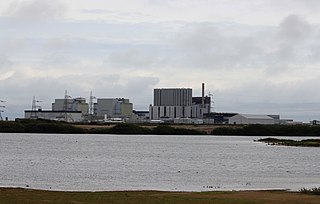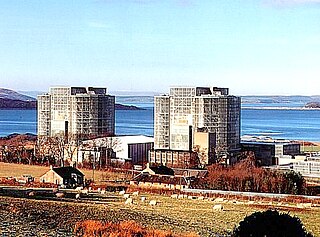
Sellafield, formerly known as Windscale, is a large multi-function nuclear site close to Seascale on the coast of Cumbria, England. As of August 2022, primary activities are nuclear waste processing and storage and nuclear decommissioning. Former activities included nuclear power generation from 1956 to 2003, and nuclear fuel reprocessing from 1952 to 2022.
Westinghouse Electric Company LLC is an American nuclear power company formed in 1999 from the nuclear power division of the original Westinghouse Electric Corporation. It offers nuclear products and services to utilities internationally, including nuclear fuel, service and maintenance, instrumentation, control and design of nuclear power plants. Westinghouse's world headquarters are located in the Pittsburgh suburb of Cranberry Township, Pennsylvania. Brookfield Business Partners, a Canadian private equity fund and a subsidiary of Brookfield Asset Management is the majority owner of Westinghouse.

Magnox is a type of nuclear power / production reactor that was designed to run on natural uranium with graphite as the moderator and carbon dioxide gas as the heat exchange coolant. It belongs to the wider class of gas-cooled reactors. The name comes from the magnesium-aluminium alloy, used to clad the fuel rods inside the reactor. Like most other "Generation I nuclear reactors", the Magnox was designed with the dual purpose of producing electrical power and plutonium-239 for the nascent nuclear weapons programme in Britain. The name refers specifically to the United Kingdom design but is sometimes used generically to refer to any similar reactor.

The Dungeness nuclear power stations are a pair of non-operational nuclear power stations located on the Dungeness headland in the south of Kent, England.

Chapelcross nuclear power station is a former Magnox nuclear power station undergoing decommissioning. It is located in Annan in Dumfries and Galloway in southwest Scotland, and was in operation from 1959 to 2004. It was the sister plant to the Calder Hall nuclear power station plant in Cumbria, England; both were commissioned and originally operated by the United Kingdom Atomic Energy Authority. The primary purpose of both plants was to produce weapons-grade plutonium for the UK's nuclear weapons programme, but they also generated electrical power for the National Grid. Later in the reactors' lifecycle, as the UK slowed the development of the nuclear deterrent as the cold war came to a close, power production became the primary goal of reactor operation.

The Nuclear Decommissioning Authority (NDA) is a non-departmental public body of the Department for Energy Security and Net Zero formed by the Energy Act 2004. It evolved from the Coal and Nuclear Liabilities Unit of the Department of Trade and Industry. It came into existence during late 2004, and took on its main functions on 1 April 2005. Its purpose is to deliver the decommissioning and clean-up of the UK's civil nuclear legacy in a safe and cost-effective manner, and where possible to accelerate programmes of work that reduce hazard.

Wylfa nuclear power station is a Magnox nuclear power station undergoing decommissioning. Wylfa is situated west of Cemaes Bay on the island of Anglesey, off the northwestern coast of Wales. Construction of the two 490 MW nuclear reactors, known as Reactor 1 and Reactor 2, began in 1963. They became operational in 1971. Wylfa was located on the coast because seawater was used as a coolant.
Sellafield Ltd is a British nuclear decommissioning Site Licence Company (SLC) controlled by the Nuclear Decommissioning Authority (NDA), a UK government body set up specifically to deal with the nuclear legacy under the Energy Act 2004. From 2008–2016, it was operated under licence from the NDA by a third party Parent Body Organisation called Nuclear Management Partners (NMP). Since the termination of the NMP contract it has been brought back under direct governmental control by making it a subsidiary of the NDA.

The Thermal Oxide Reprocessing Plant, or THORP, is a nuclear fuel reprocessing plant at Sellafield in Cumbria, England. THORP is owned by the Nuclear Decommissioning Authority and operated by Sellafield Ltd.

The Magnox Reprocessing Plant is a former nuclear reprocessing facility at Sellafield in northern England, which operated from 1964 to 2022. The plant used PUREX chemistry to extract plutonium and uranium from used nuclear fuel originating primarily from Magnox reactors. The plant was originally constructed and operated by the United Kingdom Atomic Energy Authority (UKAEA), but in 1971 control was transferred to British Nuclear Fuels Limited (BNFL). Since 2005 the plant has been operated by Sellafield Ltd.
EnergySolutions, headquartered in Salt Lake City, Utah, is one of the largest processors of low level waste (LLW) in America, making it also one of the world's largest nuclear waste processors. It was formed in 2007 when Envirocare acquired three other nuclear waste disposal companies: Scientech D&D, BNG America, and Duratek.
Nuclear power in the United Kingdom generated 16.1% of the country's electricity in 2020. As of August 2022, the UK has 9 operational nuclear reactors at five locations, producing 5.9 GWe. It also has nuclear reprocessing plants at Sellafield and the Tails Management Facility (TMF) operated by Urenco in Capenhurst.

The Sizewell nuclear site consists of two nuclear power stations, one of which is still operational, located near the small fishing village of Sizewell in Suffolk, England. Sizewell A, with two Magnox reactors, is now in the process of being decommissioned. Sizewell B has a single pressurised water reactor (PWR) and is the UK's newest nuclear power station. A third power station, to consist of twin EPR reactors, is planned to be built as Sizewell C.

Oldbury nuclear power station is a Magnox nuclear power station undergoing decommissioning. It is located on the south bank of the River Severn close to the village of Oldbury-on-Severn in South Gloucestershire, England. The ongoing decommissioning process is managed by Magnox Ltd, a subsidiary of the Nuclear Decommissioning Authority (NDA).

Hunterston A nuclear power station is a former Magnox nuclear power station located at Hunterston in Ayrshire, Scotland, adjacent to Hunterston B. The ongoing decommissioning process is being managed by Nuclear Decommissioning Authority (NDA) subsidiary Magnox Ltd.

Springfields is a nuclear fuel production installation in Salwick, near Preston in Lancashire, England. The site is currently operated by Springfields Fuels Limited, under the management of Westinghouse Electric UK Limited, on a 150-year lease from the Nuclear Decommissioning Authority. Since its conversion from a munitions factory in 1946, it has previously been operated and managed by a number of different organisations including the United Kingdom Atomic Energy Authority and British Nuclear Fuels. Fuel products are produced for the UK's nuclear power stations and for international customers.

Trawsfynydd nuclear power station is a former Magnox nuclear power station situated in Snowdonia National Park in Gwynedd, Wales. The plant, which became operational in 1965, was the only nuclear power station in the UK to be built inland, with cooling water that was taken from the man-made Llyn Trawsfynydd reservoir which also supplies the hydro-electric Maentwrog power station. It was closed in 1991. Its ongoing decommissioning by Magnox Ltd was expected to take almost 100 years, but in 2021 the Welsh government arranged for the power station to be redeveloped using small-scale reactors.

Magnox Ltd is a British nuclear decommissioning Site Licence Company (SLC) under the Nuclear Decommissioning Authority (NDA), a UK government body set up specifically to deal with the nuclear legacy under the Energy Act 2004. In September 2019, it became a direct subsidiary of the NDA.

International Nuclear Services (INS) is a United Kingdom company involved in the management and transport of nuclear fuels. INS is based near Whitehaven, in Cumbria and is operated by Nuclear Transport Solutions, a wholly owned subsidiary of the UK Government's Nuclear Decommissioning Authority (NDA).

Calder Hall Nuclear Power Station is a former Magnox nuclear power station at Sellafield in Cumbria in North West England. Calder Hall was the world's first full-scale commercial nuclear power station to enter operation, and was the sister plant to the Chapelcross plant in Scotland. Both were commissioned and originally operated by the United Kingdom Atomic Energy Authority. The primary purpose of both plants was to produce weapons-grade plutonium for the UK's nuclear weapons programme, but they also generated electrical power for the National Grid.



















